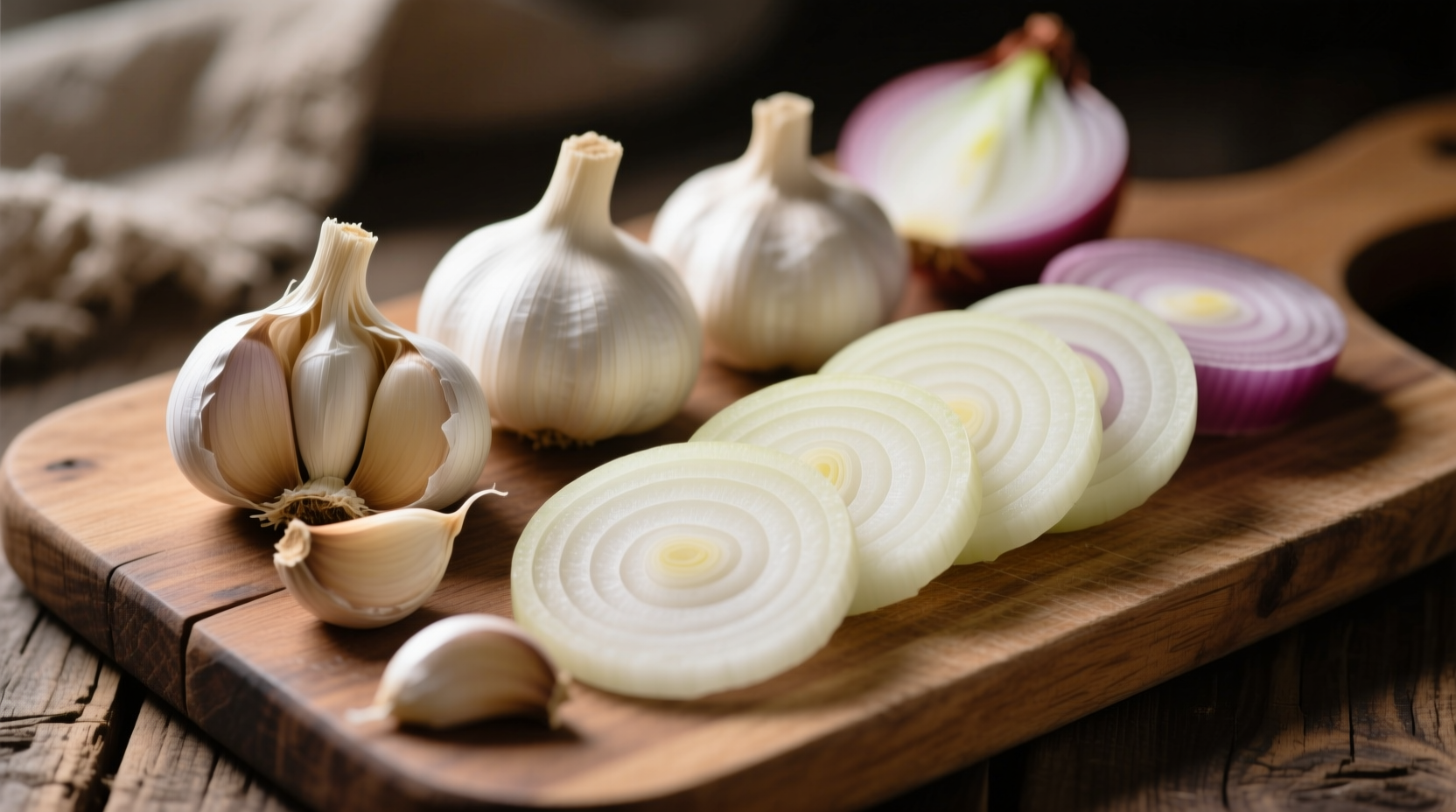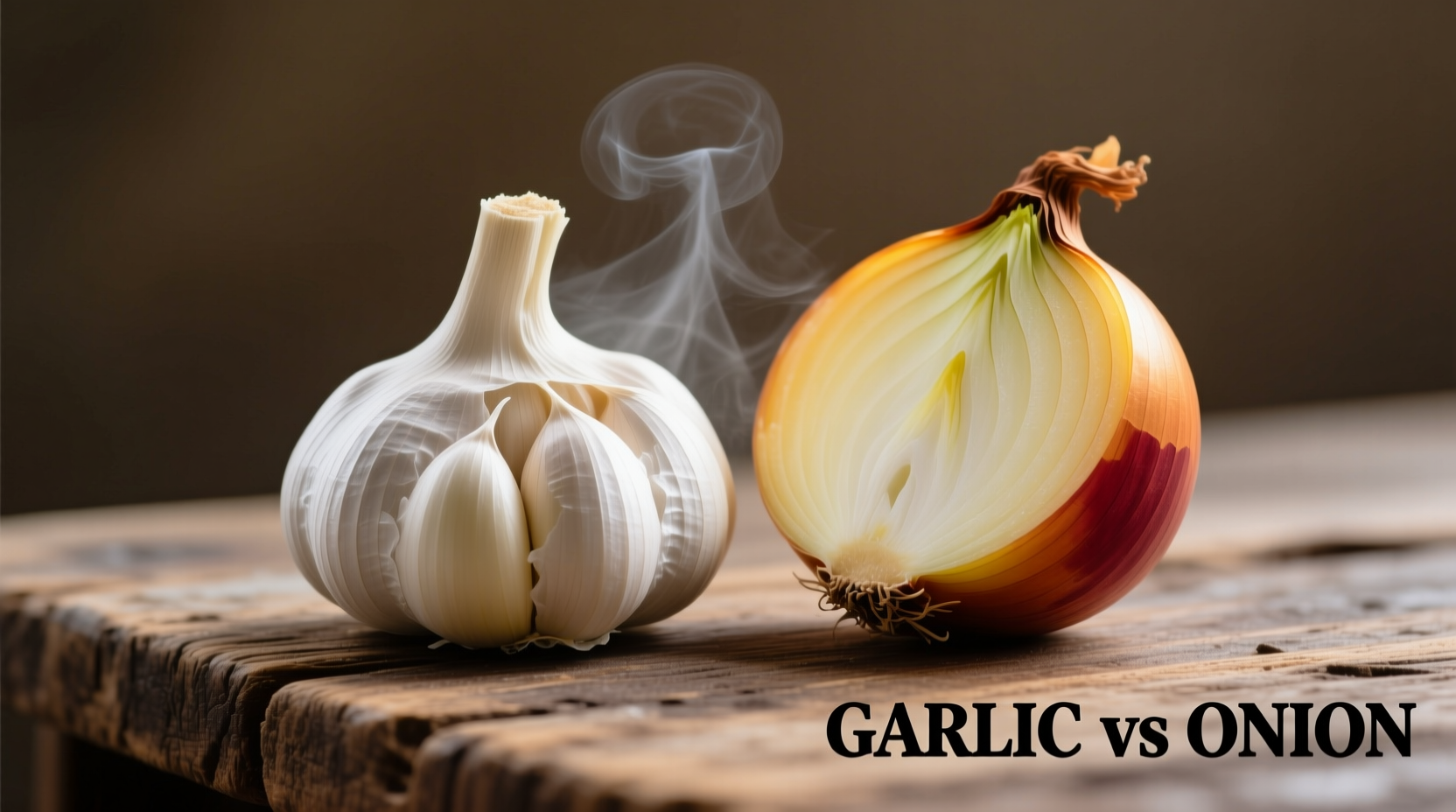Nutritional Showdown: What Science Reveals
When comparing garlic vs onion nutrition facts, both belong to the Allium family but deliver distinct health benefits. According to USDA FoodData Central, one medium raw onion (110g) contains 44 calories, 10g carbohydrates, and 1.9g fiber, while a single garlic clove (3g) provides just 4 calories, 1g carbohydrate, and 0.1g fiber. The real difference emerges in their phytochemical composition.
| Nutrient | Raw Garlic (1 clove) | Raw Onion (1 medium) |
|---|---|---|
| Calories | 4 | 44 |
| Vitamin C | 1.1mg (1% DV) | 7.4mg (8% DV) |
| Fiber | 0.1g | 1.9g |
| Allicin Potential | High (when crushed) | Negligible |
| Quercetin | Trace | High (especially red onions) |
Research published in the Journal of Nutrition confirms garlic's superior cardiovascular benefits due to its high allicin content, which forms when garlic is crushed or chopped. Onions, particularly red varieties, contain higher levels of quercetin—a flavonoid with potent antioxidant properties. The National Center for Complementary and Integrative Health notes both provide antimicrobial benefits, but garlic demonstrates significantly stronger effects against pathogens like E. coli and S. aureus (nccih.nih.gov).
Flavor Chemistry: Why They Taste Different
The garlic vs onion flavor comparison reveals fundamental chemical differences. Garlic contains alliin and the enzyme alliinase, which combine when crushed to form allicin—the compound responsible for garlic's pungent aroma. Onions contain different sulfur compounds like syn-propanethial-S-oxide, which creates their characteristic eye-watering effect.
Professional chefs understand these differences between garlic and onion impact cooking techniques:
- Garlic develops nutty, roasted flavors at 130°C (266°F) but burns easily above 160°C (320°F)
- Onions caramelize beautifully between 110-160°C (230-320°F), developing complex sweet notes
- Raw garlic delivers intense heat while raw onions offer sharper, cleaner bite

When to Use Each: Practical Kitchen Guidance
Understanding when to use garlic instead of onion transforms your cooking. Consider these evidence-based recommendations from culinary science:
Choose Garlic When
- You need antimicrobial properties in raw preparations (like salad dressings)
- Creating Mediterranean or Asian dishes requiring pungent background notes
- Seeking cardiovascular health benefits in cooked dishes
- Building complex flavor layers in slow-cooked sauces
Choose Onion When
- You want natural sweetness in caramelized applications
- Need volume and texture in dishes (onions shrink less than garlic)
- Creating dishes requiring milder allium flavor (like French onion soup)
- Seeking higher fiber and vitamin C content
Food science research shows that substituting one for the other requires adjustments. A study in the Journal of Food Science found that replacing onions with garlic in equal quantities creates overpowering results—use just 1 clove of garlic per 1/4 cup of chopped onion for balanced flavor.
Substitution Strategies That Actually Work
Many home cooks wonder can I substitute garlic for onion in recipes. The answer depends on context:
Successful Substitutions
- Garlic powder for onion powder: Use 1/8 teaspoon garlic powder per 1/4 teaspoon onion powder
- Green onions for garlic: Use 2 tablespoons chopped green onions per garlic clove in raw applications
- Shallots for garlic: Substitute 1 tablespoon minced shallot per garlic clove for milder flavor
When Substitutions Fail
Don't substitute garlic for onions in:
- Caramelized applications (garlic burns before developing sweetness)
- Raw salsas (garlic overwhelms other flavors)
- Dishes requiring onion's textural properties (like onion rings)
The American Council on Science and Health notes that while both offer health benefits, they serve different culinary functions. "Garlic works best as a flavor accent, while onions often serve as foundational ingredients," explains Dr. Andrew Weil in his food science commentary (acsh.org).
Avoiding Common Preparation Mistakes
Even experienced cooks make these garlic and onion mistakes:
Garlic Errors
- Burning during sautéing (cook over medium-low heat)
- Adding too early in cooking process (add near end for raw applications)
- Not allowing time for allicin development (let crushed garlic rest 10 minutes)
Onion Errors
- Using wrong variety for application (yellow for cooking, red for raw)
- Not properly caramelizing (requires 30-45 minutes over low heat)
- Storing cut onions improperly (keep in airtight container for 7-10 days)
Professional chefs recommend storing whole garlic at room temperature away from sunlight, while onions need cool, dark, dry conditions. Never store either in the refrigerator unless cut—moisture accelerates spoilage.











 浙公网安备
33010002000092号
浙公网安备
33010002000092号 浙B2-20120091-4
浙B2-20120091-4